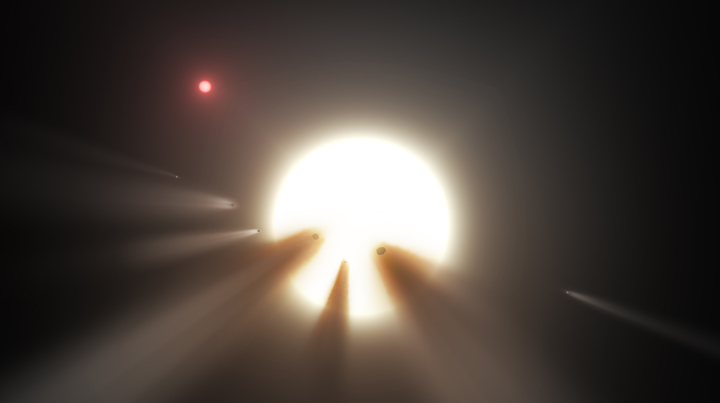You may have heard about KIC 8462852, a star roughly 1,500 light years away that has had the scientific community throwing around a word usually reserved by UFO-hunters: “alien.”

This star, more commonly referred to as Tabby’s Star (named after the astronomer who studied its unique behaviour) is, quite frankly, just plain weird.
READ MORE: Mysterious signal from space: Is it alien or an unknown phenomenon?
Last October, astronomers published a paper on Tabby’s Star detailing how its light curve was unconventional.
One of the few ways astronomers detect exoplanets (planets orbiting other stars) is by measuring a light curve — a dimming — as an object passes in front of the parent star.
Using the Kepler Space Telescope, citizen scientists — people like you — who volunteered in the search for exoplanets, reported that the light curve was “bizarre” and “interesting.”
And they were right: the light curve was dipping by around 20 per cent. To put that in perspective, most stars dim by about one per cent. This was significant.
You might think it was a giant planet, but even the largest planets we know — Jupiter-sized — would still result in a meagre one per cent dip.
- Invasive strep: ‘Don’t wait’ to seek care, N.S. woman warns on long road to recovery
- Ontario First Nation declares state of emergency amid skyrocketing benzene levels
- T. Rex an intelligent tool-user and culture-builder? Not so fast, says new U of A research
- Nearly 200 fossil fuel, chemical lobbyists to join plastic treaty talks in Ottawa
Astronomers couldn’t account for this massive dip in brightness. They ruled out instrumental effects, dust clumps from forming planets, or debris from a giant impact in a planetary system.
This, in turn, got people thinking that it could be an alien structure.
Before you think it’s a conspiracy theory, in the search for alien life — of which there is good reason statistically to believe that we are not alone in this vast universe — there is a theory that suggests how we might first notice another civilization.
In the 1960s, Freeman Dyson theorized that alien civilizations will one day have need for a massive energy source. One of the most effective ways of obtaining such energy could result in the construction of a massive structure around a star — think of it as giant solar panels — that would gather all the star’s energy output. This came to be known as the Dyson sphere or Dyson swarm. If one of these giant structures was observed from afar, the observer would see large dips in a star’s brightness.
In January, however, a new theory emerged: that the star’s brightness was dipping due to a swarm of comets. No aliens.
But now this star got even stranger.
In a paper published this week, an astronomer went back through observations of the same star from 1890 to 1989. Using different methods to examine the star, he found that KIC 8462852 has been fading by about 20 per cent over that time period.
This star isn’t anything special. It’s considered an F-type, main sequence star — a star that is about one to one-and-a-half times the mass of our own sun and slightly hotter.
“The KIC8462852 light curve from 1890 to 1989 shows a highly significant secular trend in fading over 100 years, with this being completely unprecedented for any F-type main sequence star,” author Bradley Schaefer noted in his paper.
“Such stars should be very stable in brightness, with evolution making for changes only on time scales of many millions of years.”
That’s right: any changes should take millions of years, not 99.
Weirder still, the fading isn’t constant: sometimes it has dimmed and then brightened. It is something that astronomers have never witnessed before.
READ MORE: Is there alien life on this comet? Probably not, despite what two scientists say
The author also noted that in order for this type of dimming to occur, you’d need to see roughly 648,000 giant comets.
“I do not see how it is possible for something like 648,000 giant-comets to exist around one star, nor to have their orbits orchestrated so as to all pass in front of the star within the last century,” Schaefer concluded. “So I take this century-long dimming as a strong argument against the comet-family hypothesis to explain the Kepler dips.
What does this all mean? It means that we still don’t know what’s going on around KIC 8462852. Could it be a Dyson swarm? Who knows? But either way, you can bet that this star will be studied in great detail, perhaps uncovering a previously unseen, unknown celestial mystery. Or maybe it’s aliens.



Comments